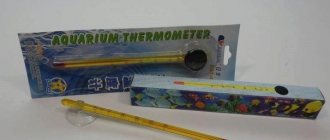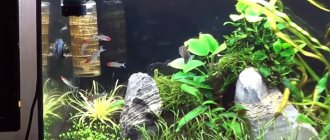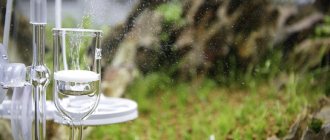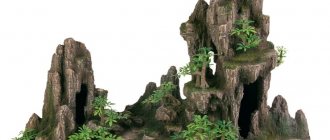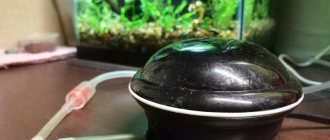In some cases, it is better to use natural decorations than their artificial counterparts. So, you can and should use soil for an aquarium with your own hands, provided that it is processed properly. In this article we will describe in detail how the substrate should be prepared and laid, and what kind of soil can be used.
Functions of soil in an aquarium
Soil performs a number of important functions; without it it is impossible to maintain the integrity of the ecosystem.
The soil is “responsible” for the following:
- It serves to securely secure the roots and hold the plant bodies.
- It is analogous to soil on land, accumulating nutrient organic and mineral substances for plants and microorganisms.
- Performs the functions of both a mechanical and biological filter, because it is a springboard for nitrifying bacteria that maintain biological balance in any ecosystem.
- It serves as a home for microorganisms, worms, and shellfish. Crustaceans and some fish burrow into it.
- For humans, aquarium soil performs another important function - aesthetic.
Of course, the soil and silt in natural reservoirs are more fertile, but they are not fundamentally different from artificial stones in an aquarium.
Effect on biological balance
In any environment, soil is an accumulator of mineral and biological substances used by plants to build their bodies. Bacteria and single-celled fungi live in the soil, processing dead organic matter into the simplest inorganic compounds. Plants use these substances during the production of energy during the process of photosynthesis to build their bodies. Greens are eaten by fish and crustaceans, and larger animals eat them. Eventually they die, end up in the soil, and the cycle begins again.
It is the soil that first suffers from improper care or other human influence. Mechanical damage, siphon cleaning, changes in acidity and hardness - all this affects the state of soil microorganisms.
The aquarium soil is also subjected to treatment that is useful from a human point of view: fertilizers for aquarium plants are added to it, aerators and filters are installed, loosening occurs too frequently, which also upsets the delicate balance.
Influence of soil on biological balance
If a lot of plants are planted in an aquarium, it is called an herbalist. Such a body of water cannot exist if there is a lack of minerals in the soil.
Waterfowl and vegetation are in close connection with each other (some fish feed on algae), so the condition of the grass inside the aquarium requires the creation of special conditions.
Ground coating
For many years, experts have been arguing with aquarists regarding the specifics of imparting nutritional value to the substrate. This is where “craftsmen” appeared, mixing street soil with manure, peat, clay or coal. These components are allowed to be used, but only in small dosages and for a specific plant. You should not make a general replenishment of the aquarium with these substances; it is better to use those that can create a comfortable environment not only for vegetation, but also for individual types of fish.
For example:
- marble chips can increase the alkaline balance and add hardness to the water;
- peat is used to acidify the liquid and soften it.
Types of soil
Natural
This group includes materials of natural origin that have not undergone any processing other than disinfection. This group includes gravel, sand, pebbles, quartz, crushed stone, and mollusk shells. Fired clay is also sometimes included here.
Such a substrate is very poor, it does not contain organic matter at all, so it will take at least six months for decomposed remains of food and excrement to accumulate, which the thickets can use for nutrition. You can use special fertilizers in the form of solutions and tablets to increase fertility. However, you need to calculate the concentration very carefully so as not to overfertilize the environment.
Chemically treated
Such granules are obtained as a result of a long process of transformation of natural substances. The soil is subjected to mechanical and chemical treatment, as a result it acquires properties that are very different from the properties of the natural material. An example of such a substrate is sawdust or coconut fiber that is mechanically crushed and treated with chemicals.
Artificial
Some companies produce special artificial mixtures. Such substances are more suitable for herbal and shrimp aquariums. Most often, nutritional complexes are based on a mixture of fertilizers and solid components that serve to adhere particles to each other and securely anchor plant roots.
How does soil change the hydrochemical composition of water?
Soil is a so-called cation exchanger; it acidifies water (lowers pH) and reduces water hardness. When interacting with water, positively charged hydrogen ions (H+) are released. The higher the H+ content in water, the more acidic it becomes. Positively charged hydrogen ions also react with sodium carbonate ions to form carbonic acid. As a result, the carbonate or temporary hardness (KH) of the water also decreases, since it depends on the content of hydrocarbonate anions - HCO3. In addition, aquarium soil binds calcium and magnesium cations (Ca 2+, Mg2+) from the water, which determine the total hardness (GH) of the water, thereby softening it.
More information about the hydrochemical composition of water
Thanks to its cation exchange ability, soil retains (stores) important nutrients for aquarium plants and releases them when needed. In this situation, the exchange goes in the other direction: the plant roots release hydrogen ions, which exchange in the soil with bound nutrient cations such as ammonium and potassium. The released nutrient ions are then absorbed by the roots.
Nutrient substrate: composition
Clay
This material is highly valuable for creating beautiful compositions in the aquarium. But a large amount of clay can be detrimental to aquatic thickets.
The following properties may appear:
- heavy clay almost does not allow water and air to pass through, as a result the roots will suffer from suffocation and will not be able to grow;
- such material is too hard for some types of greenery;
- a large amount of humus in some types of clay can lead to the rapid development of harmful algae and water blooms.
In terms of chemical composition, blue clay is considered ideal. No less popular are the red, forest and lake subspecies of this breed. But you need to lay such a substrate with caution. Red clay contains a lot of iron, which in excess is harmful to mollusks and small fish, while forest and lake types contain pure humus.
Coal
Coal is one of the most effective adsorbents. The pores of the mineral retain pollutants on their surface and neutralize harmful decay products of organic matter. It is better to lay coal in the middle layer, not on the surface, otherwise it will quickly turn into dust and its effectiveness will decrease.
It must be taken into account that coal does not dissolve sediment and does not “digest” it, therefore, when shaking, all substances will again enter the water column. That is why experienced aquarists advise removing the old carbon layer every 8-10 months and replacing it with a new one.
Peat
This compound is very rich in organic matter, therefore it serves as an “energy station” for the entire bottom. Peat and river silt can “feed” many plants; these materials are especially valuable for species with a powerful root system.
However, it is very important to choose the right dosage, because peat and silt can lead to souring of the entire tank. It is better to use higher quality granular or tablet pressed soil. Natural forest peat is too active, which can lead to changes in the fluid parameters in the “house” for fish.
Sand and small pebbles
These materials are considered optimal for novice aquarists. Smaller granules are easier to handle, safer for animals, and hold vegetation more firmly.
Remember: natural does not always mean better. Breeds that easily dissolve in water are strictly prohibited from being placed in an aquarium. Such dangerous substrates include marble, shell rock, coral sand and a number of other minerals that quickly decompose in a mildly acidic environment.
It is equally important to choose the right size of sand fractions so that they do not clog the fish’s gills and impair visibility. The pebbles should be soft; aquarium gravel can only be placed with rounded edges so as not to injure the inhabitants of the tank.
Chopped leaves and coconut fibers
Some types of fish and thickets require porous organic “soil”, which can only serve as plant debris - leaves or coconut fiber. It is not recommended to make such a substrate yourself; it is better to purchase it from a reliable manufacturer.
Such substances undergo oxidation very quickly, so they need to be replaced frequently. It is better for experienced aquarists to cover the bottom with such materials, who will be able to control the aquatic environment and will not allow the slightest changes in hardness and acidity. Not all fish and shellfish will be able to live on a substrate made of coconut fibers - do not forget about this.
Special sorbents
Such mixtures are sold in stores. In fact, each brand produces a substrate of a certain composition and patents its product, so it is very difficult to generalize all products of this type.
These mixtures are light and porous, the granules contain oxygen-free zones inside, which has a beneficial effect on the condition of colonies of beneficial bottom microorganisms. The mixtures are neutral in reaction and contain all the macro- and microelements necessary for an underwater garden.
The quality of special sorbents varies greatly depending on the brand, price category and country of origin. For example, the specialized substrate rich in mineral compounds Aquael Aqua Grunt and Aquael Aqua Floran are named one of the best. Such mixtures even contain aluminum, manganese and silicon, which increases the “efficiency” of photosynthesis in green pets.
Fertilizers in tablet form
The choice of tablets for the aquarium is varied: CO2 tablets, O2 oxygen tablets, peat tablets. And not all aquarists know why they are needed and whether they are needed at all.
So, let's start with O2 tablets. Hydrogen peroxide can be used instead. Take a syringe and add peroxide to the bottom of the aquarium, obtaining clean and cheap oxygen.
CO2 tablets will never replace a full carbon dioxide supply system. Therefore, it makes no sense to buy them three times a day. It's better to grow plants without them.
Let's talk in more detail about nutritional tablets. The popular Tetra PlantaStart and Tetra Plant Crypto tablets contain microelements and growth stimulants necessary for plants. Both products are intended for beginner aquarists only. The fact is that in beginner aquariums, nitrogen compounds and phosphates are present in any case and often in fairly large quantities.
If you add macroelements to such a jar, then from their excess the fish will be poisoned, and algae will begin to grow instead of plants. Therefore, before purchasing nutritional tablets, study their composition and buy what plants need - tablets with micro or macro elements.
The composition of peat tablets includes peat, biohomus and zeolite. Among such products, nutritional tablets from AQUAYER are the most popular. The composition includes microelements, humic acids. A tablet placed under the roots of the plant silts the soil and promotes the development of beneficial bacteria in it. Peat tablets are placed in loose herbal pots, where there is no need for a substrate. But this product also has a drawback. About a year after fertilizing the plants, the soil becomes heavily silted, and redox processes in it are disrupted. To improve the condition, you will need a good soil siphon with plant replanting.
Which soil to choose
By color
For all, without exception, the inhabitants of the aquarium, the color of the bottom does not matter - the animals either distinguish it poorly, or it does not affect their behavior or instincts. Therefore, many professionals recommend choosing the color of the soil, assessing its aesthetics. It is necessary that the aquarium be harmonious, and at the same time form a single ensemble with the interior of the room in which it is located.
It is equally important to evaluate the color of the fish. As a rule, to emphasize the diversity of their pets, owners choose dark-colored material for arranging the bottom. Blue fish will be even brighter against a gray background. Red and yellow animals are best suited to very dark, almost black soil.
By particle size
It is equally important to evaluate the size of the granules when laying the soil. Some fish, for example, kulya, can only live in small soft pebbles or sand - this is due to their lifestyle. Most African cichlasomas and inhabitants of marine aquariums prefer large stones and grottoes, alternating with a thin layer of sand.
Most species that spend most of their time at the surface or in the middle layer of water are indifferent to the size of the particles of the bottom mound. However, when planning the arrangement of an aquarium, it is better to choose in advance the type of soil in size based on the characteristics of keeping your pets.
For plants everything is different. To exist normally, they must be fixed on a fine-grained substrate. The optimal granule size is up to five millimeters. Bushes with weak roots need fine-grained soil. If the root system is powerful, you can use medium- and even coarse-grained fractions.
By nutritional value
Nutritional classification is important for aquarium greens - it only affects fish indirectly. The more peat, clay and sand with a layer of organic matter, the more fertile the bottom will be. Sand, stones and artificial media in a new aquarium do not contain any nutrients, so it is better not to plant plants in such a container without feeding.
You can feed the soil with special fertilizers in the form of granules, tablets and solutions to provide the underwater garden with everything it needs. This is especially true in herbalism, because the rule works: the more vegetation, the more often and more abundantly fertilizers need to be applied.
By layer thickness
This indicator also depends on the pet’s species and kingdom. Fish, mollusks and crustaceans need from two to ten centimeters of soil, depending on their lifestyle and feeding method. The standard is a substrate of 7-8 centimeters.
For plants everything is different. They need at least five centimeters. However, some births will require ten centimeters or more. You always need to be guided by the degree of development of the root system. Medium-sized roots require a soil thickness of 6-8 centimeters.
Why is it needed?
Substrate for aquarium plants is used primarily to create a pond with plantings, aqua design, and for the health of various types of fish and other aquarium inhabitants. This is a source of nutrition for plants that have a root system; thanks to the nutritious soil, rapid growth and long life are ensured.
It contains useful microelements:
- potassium;
- iron;
- magnesium;
- nitrogen.
The color and health of the plants in the aquarium depend on these and other important substances in the soil. A good nutrient substrate will help in the fight against algae, due to the acceleration of the growth rate of plants relative to pests of the reservoir.
Nutrition obtained from the soil enters the plant through the roots and ensures the normal development of stems and leaves.
Benefit:
- reduction of water hardness;
- decreasing the acidity of the environment;
- active growth of beneficial bacteria;
- the number of protozoa increases, which become food for young shrimp.
How to make it yourself
Substrate selection
If you want to make soil with your own hands, sea pebbles, crushed stone, sand (especially quartz), which contain little sandstone, limestone and marble, are best suited for these purposes. If you collect stones and sand from the nearest fresh water body, it will be as safe as possible for fish.
If you have a saltwater aquarium, you will need certain breeds. This type is considered the prerogative of experienced aquarists who know what more affordable materials can replace tropical grottoes.
It is strictly prohibited to collect peat, clay and organic matter in the forest! Such materials only need to be purchased in stores.
Sometimes careless owners add earth, untreated sawdust, and even cat litter as a substrate. It is not surprising that after such experiments the inhabitants of the aquarium die.
Preparation and disinfection
To be sure to destroy harmful bacteria, fungi and viruses, you need to carry out a comprehensive disinfection.
Processing stages:
- Rinse the collected material under running water.
- Pour the substrate with a bright pink solution of potassium permanganate for 20-30 minutes.
- Rinse the soil with water again to remove any remaining potassium permanganate.
- Boil the soil for at least 45 minutes or keep in the oven for 40-50 minutes at a temperature of 180-200 °C.
Methods of thermal and chemical treatment with permanganate can be used separately, if the duration of the procedure is increased by two to three times.
Placement in an aquarium
The soil can be laid immediately after treatment and disinfection. It is best to place the substrate evenly - the fish will dig holes themselves if they want. Sometimes aquarists create an optical removal effect - they pour a small layer in front and gradually increase it towards the rear wall. This technique is very effective.
Unbeknownst to us, the soil in the tank is constantly mixed, so creating patterns on the bottom of the aquarium is pointless - they will quickly collapse and turn into multi-colored chaotic spots, which will only spoil the appearance.
Multilayer soil should be laid as follows:
- To prevent dust and turbidity from rising, you need to lay larger fractions on top - flat pebbles, mild crushed stone or coarse sand.
- The bottom layer should be made of smaller fractions - medium-grained sand.
- The next layer consists of adsorbents. Activated carbon is most often used.
- Nutrient substrate for an aquarium. It involves peat, clay mixed with sand or fertilizer granules in fine-grained sand.
- The bottom layer can be different, but most often, to slow down acidification, medium-grained sand of the same size is used. It is not recommended to stack granules of different sizes, as this will accelerate the accumulation of organic matter and lead to souring.
After distributing the soil, it is necessary to install the decorations, plant the plants and apply fertilizing, if you cannot do without it.
Beginning of biological processes
It takes time for the nitrifying bacteria that maintain balance in the ecosystem to multiply in the aquarium. This is why siphon cleaning of the bottom of the tank cannot be carried out for the first two weeks. During this period, it is also not recommended to apply fertilizers if natural analogues (for example, peat or dissolved organic matter with feed) can be used without them. It is always safer to use natural nutrient soil for aquarium plants.
To speed up the process of “reviving” the aquarium, you can add a little water from another tank populated with fish. In this case, beneficial microorganisms and organic matter will accelerate biological processes. In order not to risk the health of your pets, it is better not to introduce fish, snails and crustaceans in the first two weeks of operation of the aquarium.
Tests
On the second day I took tests.
The indicators are as follows: Nitrate NO 3 - 40; Nitrite NO 2 - 0.4
For two days the water was slightly cloudy; on the third day the cloudiness disappeared, but foam appeared on the surface of the water.
The foam went away within 24 hours. The aquarium was illuminated for 4 hours with two lamps of 20 W warm light. Starting from the third day, I increased the lighting by one hour every day. A week has passed since the aquarium was set up; small growth of plants is observed only in Schisandra compacta and Lagarosiphon.
Soil care
Cleaning
It is best to clean the soil in an aquarium using a siphon. You need to clean the bottom according to certain rules.
It is recommended to comply with two conditions:
- cleaning the aquarium and the entire surface of the bottom should be done in one “session”;
- No more than 30% of the water should be drawn in during the entire procedure.
You need to hold the siphon in one place until two-thirds of the debris has been removed. It is easier to use a long hose to drain the water not into a bucket, but into a sink or toilet. If there are no roots that can be damaged, it is recommended to lower the siphon funnel as low as possible in order to not only clean, but also loosen the soil.
Most often, it is better to wear two attachments: a large one for quickly cleaning free areas, and a thin one for cleaning objects, plants or hard-to-reach places in the tank, such as corners. Clean thoroughly, lifting all decorations. It is also important to consider that such cleaning is a long process. It's better to put it off until later if you're in a hurry.
You can only clean the bottom of the aquarium without draining the water using an electric siphon. When this device operates, the water does not drain, but passes through the second compartment and, being cleaned, immediately returns to the aquarium. All dirt is collected in a special garbage container, which can be cleaned like a vacuum cleaner filter.
Replacement
It is not recommended to replace the soil, not counting the coal layer, without a good reason, as this will cause serious damage to the mini-ecosystem. Most often, a complete replacement is associated with restarting the aquarium, but if there is no goal to get rid of harmful algae or cloudiness, you can replace the substrate in an existing aquarium.
Restart happens like this:
- First, you should move all your pets into tanks - fish separately from plants.
- Drain the water. Turn off the filter, aerator, heater and lighting.
- Remove decorations, driftwood and other large objects.
- Remove old soil and fill in new, pre-treated soil.
- Install decorations, plant plants, refill with old water if it is of good quality.
- Move the inhabitants into the old container.
The simplified method (without restarting) is only suitable for finely dispersed substrate.
It works like this:
- Place small fish. Large ones, such as cichlids, can be left in the container, because they will not fit into the siphon hose.
- Using a large 16/22 hose, draw in the soil along with water. It is advisable to save as much water as possible, so the siphon should not be torn off from the substrate.
- Fill in new soil and level it.
- Add fresh water and return the fish.
Any manipulations with the soil upset the ecological balance, so in the first days after replacing the soil in an existing aquarium, you need to control the content of nitrogenous substances using drop-check tests or paper indicators.
Question: Water filtration?
Answer: Water filtration is carried out using conventional filters. Whether internal or external, however, you need to make sure that the filter does not take the earthen layer into the filter elements, otherwise it will sour there and instead of benefit, such a filter will only do harm. It is advisable to turn on the filter only a few days after starting the aquarium. Even if fractions of the earth appear through the layer of soil with which the earth is covered, the earth must be carefully siphoned off.
If the water turns yellow, it is advisable to put it in a filter for several months. Filler with activated carbon, which will remove yellowness. All other additives such as zeolite, etc. are used exclusively individually.
Decoration
Nowadays, aquascaping is a fashionable trend - decorating an aquarium in the form of a beautiful natural (not necessarily underwater) landscape. If you do not want to chase fashion, but want to show individuality, it is better to listen only to your imagination. You can create an urban picture or a psychedelic landscape in your pond with a bright pink bottom, ultraviolet lighting and phosphorescent fish.
Once you have decided on the style, you need to start thinking about the composition. The accent, the energy center of the display in the aquarium, can be a snag, a hummock, a stone or group of stones, a bush, as well as a castle or grotto. It is recommended to locate this epicenter not in the middle of the aquarium, but slightly to the right or left, observing the proportions of the golden ratio.
You can use stones. To prevent large fish from knocking them over, it is recommended to tie or glue the boulders together. In shrimp tanks, the most popular are large pieces of sandstone with many small caves, and in cichlid tanks, flat stones are often used, which are placed on top of each other, building grottoes and caves. If the aquarium is intended more for beauty, you can decorate it in the Japanese Iwagumi style, creating a garden from an odd number of stones of different sizes standing or lying on the bottom.
You can use purchased or hand-crafted driftwood. It is beautiful in itself, but if you wish, you can additionally decorate the wood with moss, plants, pebbles and shells.
As additional decorations, clay shards, ceramic tubes of different diameters can be used (catfish and loaches like to occupy the large ones, shrimp like the small ones), and halves of a coconut shell. You can grow moss or fern onto the coconut. Nowadays, all kinds of bubble-blowing crocodiles and divers in aquadesign are considered signs of bad taste, but when decorating an aquarium in a nursery, their presence is quite justified.
Required amount
Sometimes it is very difficult to know in advance exactly how much soil you will need. You will need to take into account a couple of factors and make calculations. Nutrient soils are very expensive, so they are not used for aquariums larger than 30 liters.
So, aquarium plants on average require about 3 cm of soil . And those that have large roots - at least 5 cm.
There is a certain calculation formula.
Aquarium length (cm) x width (cm) x soil layer (cm), all divided by a thousand = Volume required in kilograms.
Example:
20 cm x 40 cm x 5 cm / 1000 = 4 kg
Sometimes the calculation is erroneous, because... There may not be enough soil, or there may still be some left. But this is better than determining the right amount by eye.
Basic recommendations
There are a number of simple tips for beginning aquarists on setting up an aquarium and laying out the substrate:
- The aquarium can be completely without soil if you plant plants in pots or flowerpots. Greenery itself, for example, creeping echinodorus, is also suitable as bottom “soil” litter.
- Glass soil is very popular, but few people know that it is harmful to the ecosystem. Despite the neutral reaction of glass, it is not worth using. The smooth surface of the material cannot accumulate colonies of beneficial bacteria and organic matter, so plant nutrients are quickly washed out, resulting in the death of the underwater garden.
- Even if your aquarium is in perfect condition, you will have to completely replace the soil every five years, because it will most likely have time to accumulate harmful substances and pathogens.
- If you make multi-layer soil, you need to properly monitor it. Therefore, beginners are not recommended to use this type of bottom arrangement.
Everything comes with experience, so do not despair if at first you are not quite able to cope with the maintenance of “complex” types of aquariums.
How to properly lay a nutrient substrate
Once again, we draw your attention to the fact that a nutrient substrate is only necessary for aquariums densely planted with plants. If you want the plants to grow in one corner, then use a nutrient substrate 1-3 cm thick only in this corner and separate it from the main soil of the rest of the bottom area with temporary plastic tape or a cardboard partition. Place a base soil 2-3 cm thick on top of the substrate. Decorate the rest of the container at your discretion with stones, driftwood, or leave it free.
